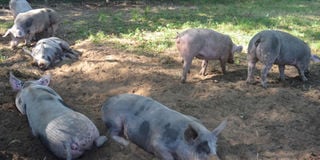Prime
Lessons for Ugandan farmers

Pigs on a farm owned by a small farmer’s cooperative in Netherlands. Photo by Esther Oluka
What you need to know:
- Every year, the International Federation of Agricultural Journalists (IFAJ), hosts journalists all over the world on a congress. This year’s edition was held in Netherlands from July 10 to 15.
- The action-packed event included conferences, workshops for journalists and farm tours within the country. Seeds of Gold’s Esther Oluka, who represented Daily Monitor, shares some lessons Ugandan farmers can learn from the thriving agricultural success in Netherlands.
Each year, the International Federation of Agricultural Journalists (IFAJ), a non-partisan, professional association for agricultural journalists in more than 40 countries hosts an annual conference in one of its member countries.
This year, the congress was held from July 10 to 15 at Wageningen University and Research, a Dutch public university in Wageningen, Netherlands. The Dutch Roots Foundation, the organiser of the event, chose “Dutch Roots: Small Country big Solutions” as the theme for this year’s congress.
Lessons for Ugandan farmers
Rely more on technology
The Dutch agriculture is a world of genomics and robotics. The farmers are always looking for tools and technology that can help improve production. On Wednesday July 11, we visited Denkavit, a company in the Netherlands that specialises in the production of high quality feeds for young animals.
Journalists got an opportunity to see an automatic feeding robot that offers farmers a chance to run other important errands as the robot feeds the animals. Jan Doornbos, sales manager at Denkavit says the robots are indeed very helpful to farmers.
“The system can estimate the amount of feeds an animal requires, meaning, it is fed exactly the right quantity of nutrients,” Doorbon says. Besides automatic feeding robots, farmers can also opt for milking robots which make it possible for cows to milk themselves.
Away from feeding robotics, journalists also visited Bayer Forward farm. At this farm is a device called an agrotop, a closed system that enables farmers to pour chemicals into a tank without contact or spillage.
Processing sweet foods into animal feeds
On Friday, July 13, journalists under the guidance of a tour guide had an opportunity to visit Nijsen/ Granico, a feed mill factory in the South of Netherlands. The company started processing surplus foodstuffs from the food industry to make semi-finished products for the manufacture of animal feeds in 1989.
At first, mainly dough-based products were recycled. Once this was found to have positive results, the range of products used were quickly expanded to include biscuits, sweets, and other kind of sweet foods.
Through its Food-for-Feed concept, Karel Van der Velden, the business development manager at the company says it is a way of replacing some of the usual ingredients in animal feeds with tasty, easily digestible food ingredients. “This leads to a high intake of feed, resulting in healthy animals that are full of vitality (being active and strong),” Velden says, adding, “High feed intakes plus healthy animals equals high production rate.” These processing of food surpluses is safe as the handling is continuously monitored by the quality assurance in place.
Group farming
On Saturday morning, July 14, we visited Herenboeren in Boxtel, where approximately 200 families share a farm, making decisions about what they grow and how they farm together.
The families operate under a small farming cooperative termed as Herenboerderij. The farmer, who is employed by the cooperative, grows fruits, vegetables and looks after animals that produce eggs and meat.
Mattie deu Vivier, one the farmers we found loading harvested cabbage and peas onto baskets says the cooperative has been very life changing.
“I produce my own food which is healthier and tastier. But also, working as a group has enabled us to help each other especially on the farm,” Vivier says, adding, “The cooperative is a great idea which I encourage other farmers across the world to either start or join.”
All participating families in the cooperative share in the annual operating cost including the farmer’s salary, utilities, and food for the farm animals, among other costs.
Invest in horticulture
Without a doubt, many people across the world include fruits and vegetables in their daily diet for health reasons. You may have heard doctors advise individuals to eat more fruits as it’s good for the body.
Louise Fresco, a professor at Wageningen University says it may actually be a great ideal for farmers to focus more horticulture (cultivating fruits and vegetables).
“Put emphasis on this because of the contribution they have towards improving health,” she advises.
Rooftop farming
It is possible to grow crops on rooftops of buildings. On Saturday afternoon, July 14, we visited the rooftop of the Schieblock office building in the centre of Rotterdam. Here, one will find a rooftop-farm termed as Dakakker with a harvestable garden cultivating fruits, vegetables, and herbs.
Wouter Bauman, a tourguide says the rooftop was considered for farming because of the easily available water from rain and the readily available space. However, in order not to damage the roof, Bauman says lightweight soil is used during the planting process.




